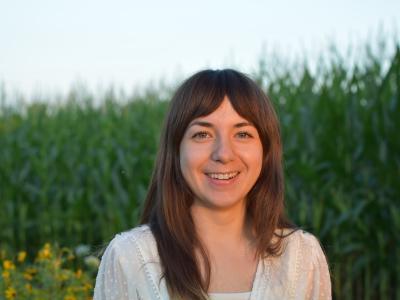The Schoens’ 20-acre forest in Manchester reflects a strong commitment to sustainable forest management. Enrolled in the EQIP program through NRCS, the site has undergone years of dedicated brush management and now stands as a model for oak regeneration. Once overrun with dense undergrowth, the property now offers a rare glimpse into the region’s once-common oak-hickory forest ecosystem. This transformation is the result of the hard work, dedicated stewardship, and thoughtful ecological restoration efforts of Pat and Pam Schoen.
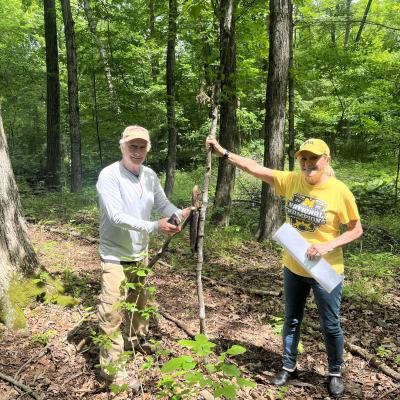
Pat and Pam demonstrating how they've repurposed a felled trunk to prop up a leaning oak sapling.
Upon arrival at the Schoens’ property, the exceptional quality of the woodland is immediately evident as the landscape opens into a classic oak savanna. Mature oaks form a scattered canopy overhead, allowing sunlight to filter through and reach the forest floor, where it nurtures a rich understory of native grasses, wildflowers, and shrubs. This open structure creates the right conditions for oak seedlings to regenerate—something that becomes difficult when invasive species or shade-tolerant trees outcompete them for light. Unfortunately, that’s the direction many oak-hickory forests in Washtenaw County are heading, as they gradually transition into maple-dominated woods due to the absence of natural disturbances.
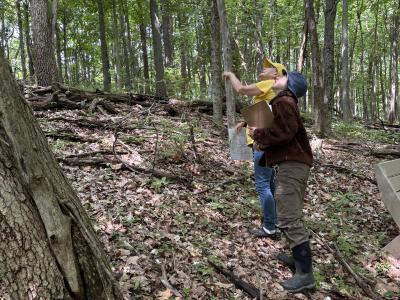
Kristen and Pam identifying trees in their oak-hickory forest.
For thousands of years, Native Americans regularly used fire to manage the land—for agriculture, travel, and maintaining habitats for plants and wildlife (2). This use of fire helped maintain Southeast Michigan’s oak-hickory forests by clearing underbrush and supporting fire-adapted species. Starting in the 20th century, fire suppression largely ended these practices, resulting in denser forests and a decline in oak and hickory populations (1). To sustain oak-hickory habitat today, management efforts must be intentional, using prescribed burns and brush cutting to maintain the open, sunlit conditions essential to oak openings—habitats that support a wide variety of specialized plants, insects, and wildlife. This rich biodiversity not only increases the ecological value of the land but also strengthens vital ecosystem services such as water filtration, which improves water quality.
Walking the property with the Schoens, their deep connection to nature quickly became apparent. They are not only attentive to the quiet details that others might overlook, but also genuinely eager to learn more about the natural world. Their approach to oak regeneration is both creative and adaptive. For example, when a tree falls, they take advantage of the resulting canopy gaps by planting oak seedlings in those open spaces. To protect the young oaks from deer, they repurpose a variety of reclaimed materials to build protective cages around them. They also carefully thin the forest where possible, selectively removing species like musclewood, for example. Its strong, straight grain makes it ideal for various projects around the property, which the Schoens affectionately call “the two-by-fours of the forest.”
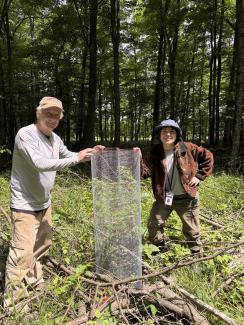
Pat shows me the young tree seedlings he's planted in canopy gaps and the sturdy wire fencing guards he built to protect them.
For the Schoens, stewardship is more than a hobby; it is a living and evolving tradition. They have named trails after their grandchildren and assigned tree seedlings for each child to care for as their own. This helps instill a sense of ownership, wonder, and responsibility as both the forest and the next generation grow together. Their nurturing spirit reaches beyond their family and land, contributing to the ecological health of the Iron Creek sub-basin in the River Raisin watershed. Through their thoughtful efforts, the Schoens are helping preserve the balance and beauty of their oak opening, ensuring these rare ecosystems and the rich diversity of life they support continue to thrive for generations to come in Washtenaw County.
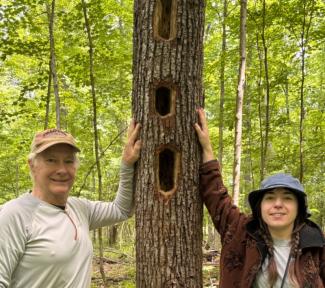
Pat was intrigued by the rounded rectangle shape a woodpecker had repeatedly carved.
(1) Nowacki, G. J. and Abrams, M. D. (2008) The Demise of Fire and “Mesophication” of Forests in the Eastern United States. BioScience.
(2) Orttenburger, M. (2021) Tree-ring research illuminates early fire history of Lower Michigan. Sparks and Flames.
